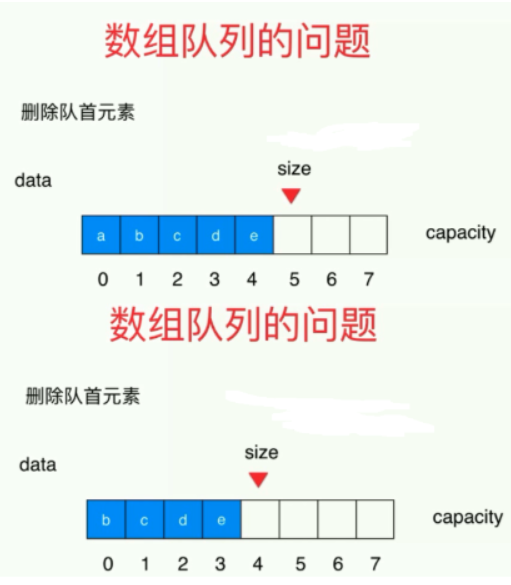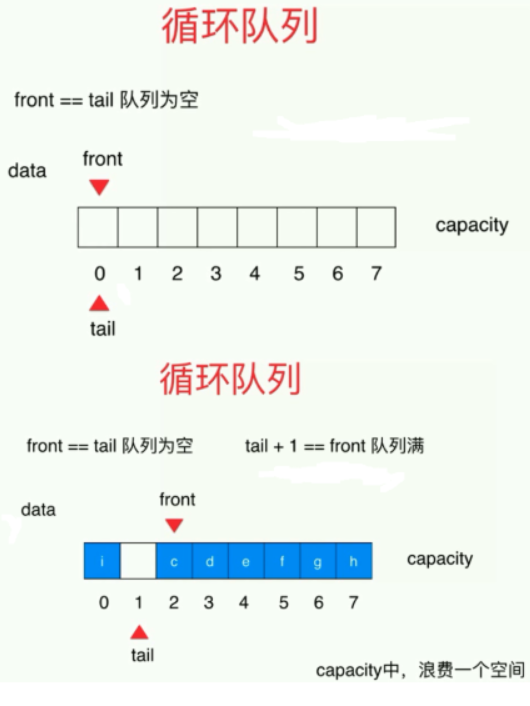栈
栈的实现
- 栈的基本功能:
public interface Stack<E> {int getSize();boolean isEmpty();void push(E e);E pop();E peek();}
- 基于动态数组的栈的实现
public class ArrayStack<E> implements Stack<E>{Array<E> array;public ArrayStack(int capacity){array=new Array<>(capacity);}public ArrayStack(){array=new Array<>();}@Overridepublic int getSize() {return array.getSize();}@Overridepublic boolean isEmpty() {return array.isEmpty();}@Overridepublic void push(E e) {array.addLast(e);}@Overridepublic E pop() {return array.removeLast();}@Overridepublic E peek() {E ele=array.get(array.getSize()-1);return ele;}public int getCapacity(){return array.getCapacity();}@Overridepublic String toString() {StringBuilder ret=new StringBuilder();ret.append("Stack: ");ret.append("[");for(int i=0;i<array.getSize();i++){ret.append(array.get(i));if(i!=array.getSize()-1){ret.append(", ");}}ret.append("] top");return ret.toString();}}
时间复杂度分析
| 操作 | 时间复杂度 |
|---|---|
| push(E) | 均摊时间复杂度:O(1) |
| pop() | 均摊时间复杂度:O(1) |
| peek() | O(1) |
| getSize() | O(1) |
| isEmpty() | O(1) |
队列
- 队列是一种线性结构
- 相比数组,队列对应的操作是数组的子集
- 只能从一端(队尾)添加元素,只能从另一端(队首)取出元素
队列的基本功能
public interface Queue<E> {void enqueue(E e);E dequeue();E getFront();int getSize();boolean isEmpty();}
数组队列
实现
/*** 基于动态数组的队列的实现*/public class ArrayQueue<E> implements Queue<E>{Array<E> array;public ArrayQueue(int capacity){array=new Array<>(capacity);}public ArrayQueue(){array=new Array<>();}@Overridepublic int getSize() {return array.getSize();}@Overridepublic boolean isEmpty() {return array.isEmpty();}@Overridepublic void enqueue(E e) {array.addLast(e);}@Overridepublic E dequeue() {return array.removeFirst();}@Overridepublic E getFront() {return array.get(0);}@Overridepublic String toString() {StringBuilder ret=new StringBuilder();ret.append("Queue: ");ret.append("front [");for(int i=0;i<array.getSize();i++){ret.append(array.get(i));if(i!=array.getSize()-1){ret.append(", ");}}ret.append("] tail");return ret.toString();}}
时间复杂度分析
| 操作 | 时间复杂度 |
|---|---|
| enqueue(e) | 均摊时间复杂度:O(1) |
| dequeue() | O(n) |
| front() | O(1) |
| getSize() | O(1) |
| isEmpty() | O(1) |
循环队列
- 数组队列的问题
出队操作,要移动数据,时间复杂度是O(n)
- 循环队列

队列为空判断条件:
front == tail
队列为满判断条件:
(tail + 1) % data.length == front
动态调整数组大小的resize函数:
private void resize(int newCapacity) {//预留一个位置,用来判断队列是否已满E[] newData=(E[])new Object[newCapacity+1];for(int i=0;i<size;i++){//将原来循环队列中数据复制到新数组,原来的data数据是从 font开始的//复制到数组,新数组是从0小标开始的newData[i]=data[(i+front)%data.length];}data=newData;front=0;tail=size;}
实现
public class LoopQueue<E> implements Queue<E>{private E[] data;private int front,tail;private int size;public LoopQueue(int capacity){//循环队列会浪费一个单位空间data=(E[])new Object[capacity+1];front=0;tail=0;size=0;}public LoopQueue(){this(10);}public int getCapacity(){return data.length-1;}@Overridepublic int getSize() {return size;}@Overridepublic boolean isEmpty() {return front==tail;}@Overridepublic void enqueue(E e) {//入队操作,先判断队列是否满了if((tail+1)%data.length==front){resize(getCapacity()*2);}data[tail]=e;tail=(tail+1)%data.length;size++;}@Overridepublic E dequeue() {if(isEmpty()){throw new IllegalArgumentException("con not dequeue from empty queue");}E ret=data[front];data[front]=null;front=(front+1)%data.length;size--;if(size==getCapacity()/4 && getCapacity()/2!=0){resize(getCapacity()/2);}return ret;}@Overridepublic E getFront() {if(isEmpty()){throw new IllegalArgumentException("con not dequeue from empty queue");}return data[front];}private void resize(int newCapacity) {E[] newData=(E[])new Object[newCapacity+1];for(int i=0;i<size;i++){newData[i]=data[(i+front)%data.length];}data=newData;front=0;tail=size;}@Overridepublic String toString() {StringBuilder ret=new StringBuilder();ret.append(String.format("LooPQueue: size=%d,capacity=%d\n",size,getCapacity()));ret.append("font [");for(int i=front;i!=tail;i=(i+1)%data.length){ret.append(data[i]);if((i+1)%data.length!=tail){ret.append(", ");}}ret.append("] tail");return ret.toString();}}
时间复杂度分析
| 操作 | 时间复杂度 |
|---|---|
| enqueue(e) | 均摊时间复杂度:O(1) |
| dequeue() | 均摊时间复杂度:O(1) |
| front() | O(1) |
| getSize() | O(1) |
| isEmpty() | O(1) |
比较
public class Main {public static void main(String[] args) {int opCount=100000;ArrayQueue<Integer> arrayQueue=new ArrayQueue<>();double t1=testQueue(arrayQueue,opCount);System.out.println("Array Queue time:"+t1+"s");LoopQueue<Integer> loopQueue=new LoopQueue<>();double t2=testQueue(loopQueue,opCount);System.out.println("Loop Queue time:"+t2+"s");}//测试使用q运行opCount个enqueue和dequeue操作所需要的时间,单位:秒private static double testQueue(Queue<Integer> q,int opCount){long startTime=System.nanoTime();Random random=new Random();for(int i=0;i<opCount;i++){q.enqueue(random.nextInt(Integer.MAX_VALUE));}for(int i=0;i<opCount;i++){q.dequeue();}long endTime=System.nanoTime();return (endTime-startTime)/1000000000.0;}}

